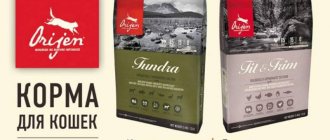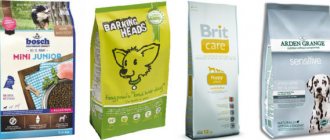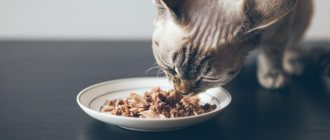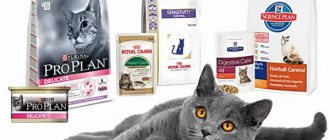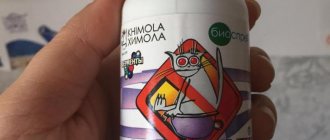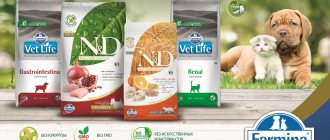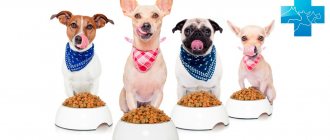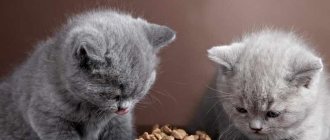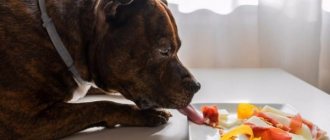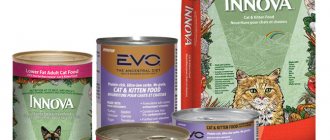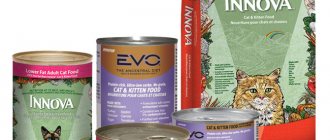The health of pets largely depends on their diet. Today, most of them eat industrial powdered formula. And in order to choose the right food for your cat, you need to be able to decipher its composition. Let’s say right away that you shouldn’t buy economy class food, they contain a lot of ingredients and flavorings that are harmful to animals, it is better to give preference to premium and super premium classes.
How dry industrial mixtures are produced
Before a brand is approved for release, feline nutritionists work. They develop and approve the composition of the final product.
According to the finished recipe, all components are mixed in special units: meat, offal, vegetable raw materials, additional ingredients - preservatives, stabilizers, additives. The finished mass is pressed through a sieve, the cells of which have the shape of future granules.
After drying, the finished pieces are treated with a special composition - a mixture of fat and ingredients that give the food a taste that is attractive to the cat.
Meat after drying cannot occupy more than half the volume, its usual rate is lower - about 35 percent, therefore, if it is not in first place in the list on the product label, this is normal.
The advantage of any food is the absence of flavors and dyes, components that are clearly harmful to animals.
The daily intake of the mixture is also important - the lower it is, the more nutritious the food.
The moisture content of dry food is always no more than six percent.
Which food is better to leave in the store?
When purchasing cat food in a store, pay attention to its composition. If dry cat food contains at least one ingredient from this list, the staff of the Murkosha shelter ask you to think about whether it’s worth buying it:
- sugar and cellulose, as well as caramel; - Propylen glycol sweetener, which is extremely harmful; — artificial dye E127, which provokes cancer; - a large percentage of by-products (it’s good if the manufacturer includes meat products that are healthy for the cat in the food, but sometimes by-products mean skin or trimmings from slaughterhouses); - the words “meat” without any specifics; - unnatural preservatives; - artificial antioxidants Ethoxyquin, BHA (E320) and BHT (E321), which can damage the liver, cause depression, seizures, and skin neuroses.
Read more about the dangers of low-quality food: Economy class cat food
Wet food
They can be considered an intermediate link between canned food and dry mixes.
The main difference is humidity and packaging. These are usually single-dose food packets that are soft morsels in a jelly or sauce. Their humidity is much higher than that of dry food, but lower than that of canned food and is no more than 35 percent.
If the cat does not finish the portion, it quickly dries out and becomes unusable. You can put half a sachet in a bowl, open it and store it in the refrigerator.
STANDARD OF THE RUSSIAN QUALITY SYSTEM
The standard of the Russian quality system for dry food (for cats), applying for the Russian Quality Mark, has established advanced requirements for the amount of dry matter, raw ash, as well as the acid and peroxide value of fat. In addition, the dry food testing program additionally included determination of the content of amino acids, antibiotics, pesticides, preservatives and dyes. Products that comply with the standards specified in the STO have the right to apply for the Russian Quality Mark. The level of localization of production for the assignment of the Russian Quality Mark must be at least 70% of the cost of the product.
The advanced requirements of the Roskachestvo standard are not mandatory for manufacturers, however, products that do not meet these requirements cannot qualify for the Russian Quality Mark.
According to statistical studies, the most popular pet in Russia is the cat. Moreover, it does not matter at all whether she is purebred or not: the percentage of people who picked up a kitten who was wandering along a deserted street in the rain with a pitiful look is very, very large. It is also very common for Russians to be indiscriminate in feeding their pets. True, this is especially true for dog owners: among them there are many who like to feed the dog what is called “from the table”. However, even among the owners of a meowing friend, as a survey by Roskachestvo on social networks showed, there is no unity.
The survey results showed that the majority of voters - 40.7% - diversify their pet's diet with wet and dry food, 30.3% - give their cat exclusively dry food, 17% - feed their pet only natural food. Only 7.3% get by with wet food. Finally, 4.7% of respondents chose “their option.” So, someone’s cat eats both dry and wet food, chicken and fish, another “gourmet” prefers fresh meat in the form of moles and mice, and a third prefers liver. There were also those who feed the cat “whatever they have.”
Since dry food makes up approximately 80% of the entire “cat food” market (and according to the survey results it turned out to be the clear leader), Roskachestvo decided to study it first.
Canned food - production and difference from dry food
Wet food is produced similarly to dry food, but instead of drying, the technology includes preservation of the semi-finished product.
The moisture content of canned cat foods - purees, stews, jelly, mousses and others - reaches eighty percent. It is important to know it in order to correctly determine the composition of other components, most importantly - proteins and fats.
For example, at 80% humidity, the can says 5% fiber content. By calculating this share from the remaining 20% of dry products, you can see that in fact its content is 25%. The same recalculation can determine the content of fats, proteins, and macroelements.
It’s a bad sign if the canned food label contains the words “flavors of.” This only means that the composition contains artificial flavors.
In developed countries, it is prohibited to write “all” on the label, which means that the product consists of 100% one component - meat, fish, etc. This is technologically impossible and is a trick of the manufacturer, a deception.
A few words about marketing
There’s food on the store counter, the price tag couldn’t be lower, and the packaging of the food is replete with the words “Recommendations from the best veterinarians!” or “Premium food!” How is this possible? Why is food strewn with awards and recommendations so cheap, what is the secret? Did the sellers really awaken to their conscience and decide to make such a gift to us and our pets?
Composition of “Our Mark” food.
The packaging says “Premium class”, but judging by the composition, this is a very dubious statement. Of course no. There are no miracles in the world, especially when the conversation turns to money. No manufacturer will operate at a loss. But then where did the phrases about recommendations, “Brand of the Year” awards and the premium quality of the product come from on the packaging of such toxic and simply harmful food, such as “Wiskas” or “Our Mark”?
The answer is simple - marketing. The manufacturer can decorate the packaging with whatever inscriptions he wants, no one will say a word to him. This aspect is not regulated by law (as discussed below), as it is considered a “design and marketing decision for packaging.” And that’s why manufacturers write whatever comes into their head, since it’s not prohibited by law. And this happens everywhere. Human foods are susceptible to the same contamination (non-GMO salt as an example).
Ingredients of Whiskas brand cat food
So let’s make a note: flashy labels on product packaging cannot be trusted.
GOST for cat food
Carefully reading the ingredients on the packaging helps in choosing cat food. And, unlike false labels on the front of the package, the composition is information that is already regulated by law. And the manufacturer, no matter how God-given a marketer he is, is obliged to indicate in the composition only those ingredients that are actually present.
Meet GOST for food for cats and other pets: R 55984-2014.
Open and read carefully:
6.3.2 The composition contains a list of components (ingredients) included in the food recipe, in order of decreasing their mass fraction. Components that are similar in product category and consumer characteristics may be combined under the name of the product category (for example, meat, meat products, fish, cereals, vitamins, minerals, vegetables), with the exception of components that are included in the name of the feed and which must be are explicitly listed in the composition.
Now it becomes much easier to determine whether the manufacturer provides high-quality food for our furbabies or not.
Street cats cannot count on quality food: they eat what they give.
But even here, cunning manufacturers manage to lie. Let's look point by point at what the composition of the food looks like and where the deception lies.
Raw natural food
A fairly young generation of super premium food. These are natural meat products, usually blast frozen. Every year they become more and more popular among supporters of healthy animal nutrition, since this diet is most similar to the natural one. In our country you can buy such food from American brands Balanced Blends, Darwin's Natural Pet Products, Primal. A well-known domestic brand is Superpet.
Natural food contains fresh raw meat (chicken, turkey, quail, beef, lamb, rabbit), vegetables, eggs (quail and chicken), bran, vitamins and microelements.
The advantages of such nutrition are the absence of vegetable protein, preservatives, flavors and flavor enhancers.
What to look for when choosing food
Be sure to study the composition. The fewer impurities, dyes, preservatives and grain/soy additives, the better. The closer to the beginning of the list the name of the product, the higher its content in this food
What else should you pay attention to when choosing food?
Look for the abbreviation AAFCO. It indicates that the product has not only passed the necessary tests of the American Feed Control Association, but also that the nutrients in this product are balanced. That is, the use of such food will provide your pet with everything it needs without “supplementary feeding” with natural food. Protein (its nature) If you see the word “protein” in the composition, then look to see if the manufacturer explains what kind of protein he uses. And also whether there are percentages of its content. Conscientious manufacturers, who care not only about profit, but also about the buyers themselves, will always indicate the percentage content and type of this protein. Amount of food Find out how much food you should give your pet. The lower this number, the better quality product you have in your hands. The high nutritional value of the food will provide your pet with the necessary energy. Ingredients Avoid products that contain bone meal, large amounts of grains or soy (they should not exceed half of the diet), many different dyes and preservatives. Give preference to those foods that contain not only vitamins (in particular E and C), but also liver and fish
This way you will provide your pet with iron and phosphorus, which are necessary for its bone and circulatory systems. Expiration date Pay attention to expiration dates, as well as where and how the food was stored.
Be sure to study the composition of the food. The less impurities, dyes, preservatives and cereal or soy additives in the food, the better. The closer to the beginning of the list the name of the product, the higher its content in this food. Look up the acronym AAFCO. This abbreviation indicates that this product has passed the necessary tests and the American Feed Control Association, the nutrients in this food are balanced, and the use of such food will provide your pet with everything it needs without additional feeding with natural food. Protein (its nature). Conscientious manufacturers, who care not only about profit, but also about the buyers themselves, will always indicate the percentage content and type of this protein. Amount of feed. The lower this number, the better quality product you have in your hands. The high nutritional value of the food will provide your pet with the necessary energy. Compound. Avoid products that contain bone meal, large amounts of grains or soy (they should not exceed half of the diet), many different dyes and preservatives. Give preference to those foods that contain not only vitamins (in particular E and C), but also liver and fish. This way you will provide your pet with iron and phosphorus, which are necessary for its bone and circulatory systems. Best before date
Pay attention to expiration dates, as well as where and how the food was stored.
Industrial feed composition tables
The tables list all possible components and evaluate them; those that may be harmful to the cat’s health are separately noted.
Meat ingredients
| Ingredient | Allowed and prohibited components | |
| Meat* | Beef pulp, fat, cartilage, heart, tongue, etc. | |
| Meat by-products | Entrails, bones and blood. There should be no horns, teeth, hooves, fur. | |
| Bird | Carcasses with bones and skin. | |
| Poultry by-products | Bird entrails, bones and blood. No - feathers. | |
| Flour | meat | Dried and ground meat and offal. Cannot contain bones, blood, fur, feathers, hooves, horns, etc. |
| meat and bone | Dried and ground meat, bones and offal. Phosphorus content – not less than 4%, calcium – 8.8%. The protein content (digested with pepsin) is no more than 12%. | |
| from offal | Dried and ground meat and offal into flour. | |
| Hydrolyzed protein | Protein broken down into amino acids. According to manufacturers, it does not cause allergies in cats. The nutritional value and safety for the animal are questionable. | |
| Bacon | Natural flavor. | |
| Bouillon | A decoction of meat and bones (the label should indicate what it is from - pork, fish, etc.). Typically includes monosodium glutamate. A good alternative to water to increase feed moisture. | |
| Fat | beef | Natural attractant, source of Omega-6 acids. |
| chicken | ||
| Chicken oil – rendered internal fat | ||
| Skim milk | Typically used only in kitten foods. Contains protein and lactose, which are not digestible by adult cats. | |
| Porcine plasma | Low quality protein from: | blood. |
| Egg powder | crushed and dried eggs. | |
*Meat - beef, pork, goats, sheep - do not require the type of animal to be indicated on the label. Poultry, venison, buffalo and others - species must be specified.
Cereal ingredients
| Fillers forming feed granules | ||
| Ingredient | Is the source, properties | |
| Corn starch | Carbohydrates | |
| Flour | corn | Carbohydrates and plant proteins. |
| oatmeal | ||
| wheat | ||
| rice made from polished white rice | ||
| Wheat gluten | ||
| Beer rice | In high quantities it destroys taurine. | |
| Tapioca | In the form of starch and flour. Low protein, high carbohydrates. | |
| Other components | ||
| Pea protein | Low quality vegetable protein. | |
| Corn gluten | ||
| Pea flour | Crushed fried peas improve the digestibility of pea flour. | |
| Dark rice | Carbohydrates, proteins, vitamins, minerals. In high quantities it destroys taurine. | |
| Barley | Source of dietary fiber. | |
Vegetables and fruits, greens
| Fillers forming feed granules | ||
| Ingredient | Is the source, properties | |
| Sweet potato | Carbohydrates and dietary fiber. | |
| Blackberry | Dietary fiber. | |
| Potato starch | Carbohydrates. | |
| Other Ingredients | ||
| Carrot | Dietary fiber. | |
| Plantain | ||
| Pumpkin | ||
| Zucchini | ||
| Blueberry | Vitamins and antioxidants, acidifier. | |
| Cranberry | Vitamins, acidifier. | |
| Rosemary | Natural preservative. | |
| Blueberry extract | ||
| Garlic | ||
| Alfalfa | Green sprouts, low quality vegetable protein. | |
| Molasses | Sugarcane waste, calcium and betaine. | |
| Ginger | Normalization of digestion | Removing hairballs. |
| Parsley | Breath freshening. | |
| Thyme | In minimal quantities, toxic, antiparasitic agents. | |
| Garlic | ||
| Yucca | Eliminates and masks unpleasant odors of granules and feces. | |
Lactobacilli
| Lactobacillus acidophilus | Probiotics are substances that contain live bacteria from the body’s own microflora. |
| Bacillus subtilis | |
| Bifidobacterium Thermophilum | |
| Enterococcus Faecium | |
| Bifidobacterium Longum |
Yeast, fiber
| Fillers forming feed granules | |
| Ingredient | Is the source, properties |
| Tomato paste | Dietary fiber. |
| Cellulose | |
| Perilla | A mint type plant. Source of Omega-3 and Omega-6 fatty acids. In concentrated form it causes diarrhea. Considered toxic. Used only in feed produced in China, Korea and Japan. |
| Other components | |
| Chicory root extract | Inulin, prebiotic*. |
| MOS, FOS | |
| Peas and pod | Dietary fiber. |
| Oat bran | |
| Beet pulp and pulp | |
| Flax-seed | |
| Seeds, skin and pulp of tomatoes | Prebiotic. |
| Brewer's yeast | Low-quality vegetable protein, prebiotic*. |
| Rice bran | Dietary fiber in large quantities is destroyed by taurine. |
*Prebiotic is a growth stimulator of living bacteria of the body’s own microflora.
Vitamins and minerals
| Ingredient | Is the source, properties | |
| Iron proteinate | Gland. | |
| Amino acid chelate | cobalt | Amino acids and vitamin B12. |
| magnesium | Amino acids and magnesium. | |
| copper | Copper. | |
| zinc | Zinc. | |
| Yodat | potassium | Iodine and potassium. |
| calcium | Calcium. In minimal quantities it can cause thyroid dysfunction. | |
| Carbonate | calcium | Calcium. Prevents granules from sticking together. |
| cobalt | Vitamin B12. | |
| Sulfate | calcium | These elements. |
| gland | ||
| magnesium | ||
| manganese | ||
| copper | ||
| zinc | ||
| chondroitin | Prevents joint disease. | |
| Phosphate | dicalcium | Phosphorus and calcium. |
| calcium | ||
| tricalcium | + prevents granules from sticking together | |
| Sodium Selenite | Sodium. | |
| Zinc oxide | Zinc. | |
| Betaine anhydrous | Choline substitute. | |
| Sodium bisulfate | Vitamin K, acidifier. | |
| Thiamine mononitrate | B1. | |
| Pantothenate | calcium | B5, pantothenic acid. |
| calcium D | Synthetic pantothenic acid. | |
| Tocopherol | Natural preservative, vitamin E. | |
Dyes, preservatives, attractants
| Ingredient | Properties, characteristics | |
| Flavors | artificial | Synthetic additives with odors. |
| natural | Obtained from natural raw materials, such as fat. | |
| Ascorbic acid | Natural preservative. | |
| Gelatin | Low quality protein, collagen. | |
| Gum | Natural gelling and stabilizing agent. | |
| Caramel | Natural dye. | |
| Sodium | nitrite | Color stabilizer, carcinogen. |
| chloride | Natural preservative, stimulator of water consumption in animals. | |
| Red 3 | Dye, carcinogen. | |
| Ethylenediamine | Iodine. | |
*Attractant is a component that affects a cat’s taste buds, attracting it.
Composition of cat food: types of meat ingredients according to AAFACO standards
Meat is the boneless muscle tissue of mammals, which may include fat, cartilage, connective tissue, etc. Meat also includes the heart muscle, tongue and internal muscles (diaphragm; muscles separating and internal organs, etc.).
Meat byproducts - all internal organs (except the heart and tongue), bones and blood (stomachs and intestines must be cleared of contents). DOES NOT INCLUDE: Horns, hooves, fur and teeth.
Poultry is a bird carcass with bones and skin (or without them). DOES NOT INCLUDE: Entrails, head, legs and feathers.
Poultry byproducts are the internal organs of poultry (including the heart, pharynx, stomach and intestines without contents), bone, blood, heads and legs. NOT INCLUDE: Feathers.
Meat meal – ground and dried meat and offal of mammals. DOES NOT INCLUDE: blood, fur, hooves, horns, hide, stomach, rumen and intestinal contents. Calcium in meat flour should be no more than 2.2 times more than phosphorus. Meat meal should not contain more than 12% pepsin digestible protein, but no more than 9% of the specified protein content may not be digestible by pepsin (enzyme).
Meat and bone meal - ground and dried meat, bones and offal of mammals. DOES NOT INCLUDE: blood, fur, hooves, horns, hide, stomach, rumen and intestinal contents. Calcium in meat and bone meal should be no more than 2.2 times more than phosphorus, and the latter should be at least 4%. Meat and bone meal should not contain more than 12% pepsin-digestible protein, but no more than 9% of the specified protein content may not be digestible by pepsin (enzyme).
Animal byproduct meal - ground and dried meat and offal of mammals. DOES NOT INCLUDE: blood, fur, hooves, horns, hide, stomach, rumen and intestinal contents. Typically contains more by-products and less meat than meat meal.
Poultry meal (houltry meal) - ground and dried poultry carcasses (including or not including skin and bones) until smooth. Calcium in poultry flour should be no more than 2.2 times more than phosphorus. Poultry meal should not contain more than 12% pepsin-digestible protein, but no more than 9% of the specified protein content may not be pepsin-digestible (enzyme).
Poultry byproduct meal is the finely ground and dried innards of poultry, including legs, heads, undeveloped eggs and cleaned stomachs and intestines. DOES NOT INCLUDE: Feathers.
According to AAFACO standards, a manufacturer is not required to indicate the animal from which meat and other meat products are obtained if they are derived from pigs, goats, sheep and beef. The manufacturer is required to identify poultry meat, venison, kangaroo meat, buffalo meat, etc.
Meat/poultry meal can be made from sick, dead or dying animals, as it undergoes special processing that allows the product to be disinfected.
Composition analysis by class
The most expensive and high-quality food is super premium food, followed by premium and economy.
The cheapest foods are the most widely advertised and are still in great demand. But you cannot feed a cat such mixtures for a long time.
Premium and super premium food are much more expensive, as they are made from high-quality raw materials and differ only in the percentage of meat ingredients.
Super premium and holistic are the best options as they serve as a complete replacement for raw meat. The high price corresponds to their quality. Even if you switch your cat to natural food, you will have to additionally introduce vitamin supplements, micro- and macroelements into the diet; this option is unlikely to be cheaper.
About the quality of raw materials
Meat ingredients are often variable—the raw materials entering production may be fresh, raw, dehydrated, or in the form of meat meal. Is there a difference? Fresh raw materials are preferable: the less the product has been processed, the more useful substances are preserved in it. If the meat is stated to be raw, this usually means that it was previously frozen, which does not greatly affect its composition.
Please make sure that the names of the ingredients clearly indicate the origin of the raw materials used, for example “rabbit meat” or “chicken liver”. This is the only way you will be sure of the stability of the product’s composition, and if an individual reaction occurs, you will be able to identify its cause.
The technology for producing dry food is such that it is impossible to use fresh meat alone - usually dehydrated (dried) is added to it. In terms of nutritional value, it is only slightly inferior to fresh and raw. Another thing is meat or meat and bone meal. This is a highly processed product, most often representing non-food waste from the meat industry. The names of such ingredients cannot be used to understand what species of animal or poultry they are made from; the composition of the flour varies from one batch to another, which does not guarantee the stability of the nutritional content.
Table of comparative analysis of feed by class
Characteristics of industrial cat food are given in the table.
| Characteristic | Trademark | % meat content | Price 1 kg, rub. |
| Economy | |||
| They contain by-products from meat ingredients, and low-quality grains and soy from vegetable ingredients. Additives include many carcinogens and artificial flavors. The cheapest and most undesirable class of food for a cat’s diet. Lead to indigestion, allergies, and chronic diseases. Sold in all supermarkets and widely advertised. | Whiskas, Friskas, Kitekat, Darling, Felix, Cat Chow (Cat Chow), Purina Van (Purina One), Perfect Fit (often classified as premium, but it does not reach it) | From 4 to 6 | From 80 |
| Premium | |||
| Average quality ingredients used. Quite a high content of animal proteins. Well absorbed by the cat's body with the least amount of indigestible waste. The cost is 20-50 percent higher than economy class. Most often sold in pet stores. | 1st Choice, Happy Cat, Hills, Proplan, Royal Canin, Yams, Probalance | From 10 to 20 | From 250 |
| Super premium | |||
| They have a balanced composition, high nutritional value, and are completely absorbed by the cat’s body. Contains natural meat and high-quality cereals. They do not contain artificial additives, taste improvers or carcinogenic substances. Expensive. Sold only in pet stores. | Monge, Leonardo, Bozita, Nature's Protection | 50 or more | From 700 |
| Holistics | |||
| Protein - only fresh and dehydrated meat and fish. No plant materials. Carbohydrates - potatoes, rice, peas, lentils. No corn, wheat. Only natural preservatives (tocopherols). Fiber - vegetables, fruits, dried berries. Hypoallergenic product. Sold only in specialized pet stores. | Akana, Orijen, Go Natural! (Go Natural), Now, Golden Eagle Holistic Health (Golden Eagle Holistic), Pronature Holistic | 50 and above | From 1450 |
Flavors and flavoring additives
Chicken seasoning Natural food flavoring additive. An excellent natural “apitizer” obtained through the hydrolysis of chicken parts and tissues.
Chicken liver seasoning Natural food flavoring additive.
Sea salt Table salt, extracted from sea water, is practically no different from ordinary salt.
Iodized salt Table salt is used to improve the palatability of food.
Salt Most ingredients already contain salt, and an excessive amount of it in food will in no way benefit the animal.
Garlic seasoning Flavor and flavoring addition to the menu
Natural flavors Contain no artificial ingredients. Basically, these are various extracts of strong broths: chicken, beef and lamb with the addition of herbs and spices.
Peppermint Refers to spices used as aromatic and flavoring additives. Peppermint is believed to help with stomach upsets and inhibit the growth of some bacteria.
Savory The homeland of garden savory is the eastern regions of the Mediterranean and Black Sea region. It was well known to the ancient Greeks and Romans. In the manuscripts of Virgil there are recommendations for using it in food to flavor it. It was especially popular in England, Germany, Scandinavia, etc.
Fennel In appearance it resembles dill, in taste and aroma it is closer to anise, but with a sweeter and more pleasant taste.
Sources of carbohydrates
As noted above, eating plant foods is not typical for obligate carnivores, which include cats. But the truth of life is that it is impossible to make dry food exclusively from minced meat: to form stable granules you need a binding component. If it is added only for technological purposes and is in the composition list after meat ingredients, everything is in order.
But there are ready-made diets where sources of carbohydrates (mainly cereals) are used as a cheap filler, which at the same time helps to increase the calorie content of the product and bring the protein level to normal. At the same time, the meat content in the food remains critically low, which means it does not meet the needs of the predator. It is easy to recognize such a product: cereals will be in the first positions in the list of ingredients.
It happens that a manufacturer uses two or more types of grain, such as corn and rice. In this case, they will move to the middle of the list, but the overall percentage of carbohydrate components will still be high.
When comparing two cat foods of similar quality, it is better to give preference to the one that does not contain grains. Legumes, which have a significantly lower glycemic index, are an excellent alternative to grains.
